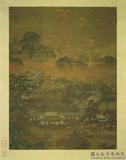明仇英觀榜圖 卷
推薦分享
資源連結
連結到原始資料 (您即將開啟新視窗離開本站)後設資料
- 資料識別:
- 故畫001608N000000000
- 資料類型:
- 類型:繪畫
- 型式:靜態圖像
- 著作者:
- 仇英
- 主題與關鍵字:
- 軍士 亭 城牆 華表 兵器 雲 楊柳 樂器 帝王 蕃族 籬笆、圍牆 松 城門 百姓 房舍 桃花 儀仗(佛教寶蓋) 欄杆 官員(臣) 孔雀 宮殿 橋 象 牌樓 奇石 侍從(侍女、童僕) 馬 高士(士人、隱士) 階梯
- 出版者:
- 數位化執行單位:國立故宮博物院
- 格式:
- 本幅 34.4x638 公分、隔水一 15.3公分、隔水二 15.5公分
- 關聯:
- 故宮書畫錄(卷八),第四冊,頁43&*故宮書畫圖錄,第十八冊,頁441-445&* 仇英(約西元一四九四-一五五二年),江蘇太倉人。字實父,號十洲。工畫山水、人物,兼擅花鳥。 本幅舊題為仇英所作。明清時代之考試主要分三級,初級為院試,及格者通稱生員,亦稱秀才。二級為鄉試,中者為舉人,榜首稱解元。最高一級為會試,舉人均可參加,中者稱貢士,榜首稱會元。貢士得入殿廷由皇帝面試,殿試成績最高者為狀元,次名稱榜眼,三名稱探花。畫中觀榜人潮洶湧,高中者興奮地登馬而去,落榜首,則滿臉沮喪,由人攙扶,頹然而返。 &* Ch’iu Ying (style name Shih-fu, sobriquet Shih-chou) was a native of T’ai-ts’ang, Kiangsu province. He was skilled in painting landscapes and figures and also excelled in bird-and-flower painting. This painting was originally attributed to Ch’iu Ying. During the Ming and Ch’ing dynasties, there were three major examinations for civil service. The first examination took place on the prefectural level, and successful candidates became licentiates and attained a Bachelor’s degree (hsiu-ts’ai). The Provincial Examination was the next level, and those who were successful at the examinations were called "Provincial Graduates" (chu-jen). The number one candidate was called Provincial Graduate with the Highest Honors (chieh-yuan). The highest examination was that on the Metropolitan level. All provincial graduates were allowed to sit for the Metropolitan Examination. Those who were succesful were called "Nominees for Office" (kung-shih), and the top candidate was called "Principal Graduate" (hui-yuan). Nominees for Office were appointed after an interview with the emperor and successful completion of the Palace Examination (tien-shih). The top candidate of the Palace Examination was celled "Principle Graduate of the Palace Examinations" (chuang-yuan); the second-place candidate was called the "Second Graduate" (pang-yen); the third-place candidate was called "Third Graduate" (t’an-hua). In this handscroll, a sea of people crowd together to find out the results of the examinations. Those who were successful excitedly mount horses and leave triumphantly. The unsuccessful candidates, however, look extremely disappointed, lean on friends, and dejectedly turn homeward.
- 管理權:
- 國立故宮博物院
授權聯絡窗口
- 國立故宮博物院圖像授權、出版授權、影音資料授權-申請流程說明
http://www.npm.gov.tw/zh-TW/Article.aspx?sNo=03003061






